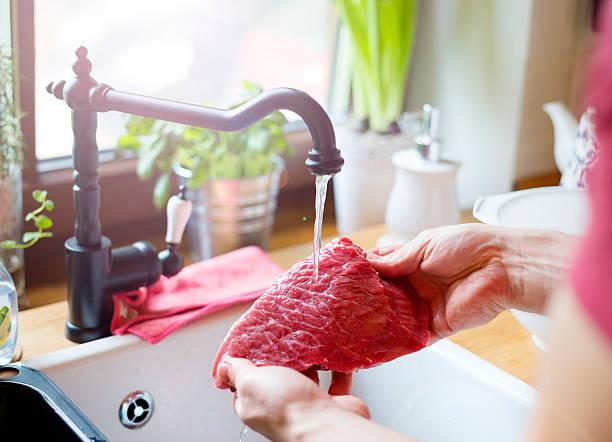Have you ever accidentally left a piece of plastic wrap on your meat while cooking?
It’s an easy mistake to make but could have serious consequences.
This post will dive into cooking meat with plastic and what to do if you accidentally cooked one.
What Happens If You Accidentally Cooked Meat With Plastic?
First things first, cooking meat with plastic is not a good idea.
Plastic is not designed for high-temperature cooking, and when it comes into contact with heat, it can release harmful chemicals that can be dangerous to your health.
These chemicals include Bisphenol A (BPA) and phthalates, which are known to have negative effects on the human body, including disrupting hormones, causing reproductive problems, and even increasing the risk of cancer.
If you accidentally cook meat with plastic, the plastic will start to melt, and the chemicals could be released into your food.

This can happen even at low temperatures, so it’s important to remove any plastic wrap or packaging from your meat before cooking it.
The extent of the damage to your meat will depend on the type and amount of plastic that was melted onto it.
Read also: Are meat absorbent pads poisonous?
In some cases, you may be able to salvage the meat by cutting off the affected areas and thoroughly washing it.

However, if the plastic has melted and fused with the meat, it’s best to discard it to avoid any potential health risks.
If you do accidentally cook meat with plastic, it’s essential to take steps to avoid it from happening again in the future.
Always make sure to remove any plastic wrap or packaging before cooking, and use cookware and utensils that are designed for high-temperature cooking to avoid any potential chemical leaching.
What to do if this happens:
The first thing you should do is assess the damage.
As we said earlier, if the plastic has only touched a small part of the meat, you may be able to salvage it by cutting off the affected area and thoroughly washing the rest of the meat.
However, if it has melted and fused with the meat, it’s best to discard it to avoid any risk.
On the other hand, if you’re unsure, look for any signs of melting or discolouration.
If it’s melted onto the meat, it may be difficult to remove, and you should err on the side of caution and discard it.
If you decide to salvage the meat, it’s essential to thoroughly wash it before cooking it again.

Use hot water and soap to wash the affected areas and ensure that all traces of plastic have been removed.
To prevent this from happening again in the future, it’s important to take precautions when handling and cooking your food.
Always check your meat for any plastic wrap or packaging before cooking it, and use cookware and utensils that are designed for high-temperature cooking to avoid any potential chemical leaching.
It’s also a good idea to avoid using plastic wrap or containers in the microwave, as the high temperatures can cause the plastic to melt and release harmful chemicals into your food.
Is Cooking with Plastic still possible? and How?
Plastic is a common material used in food packaging, but when it comes to cooking, it’s not the best choice.
While it’s possible to cook with certain types of plastic, it’s generally not recommended as they’re not really safe.
A typical example of this is cooking sausage with its wrapper. People could say it’s not bad, but there are risks, depending on what the wrapper is made of.
If you must use plastic for cooking, it’s essential to choose the right type of plastic.
Look for plastics that are labelled as ¡°food safe¡± or ¡°microwave safe.¡±
These plastics are designed to withstand high temperatures and won’t release harmful chemicals when heated.
When cooking with plastic, it’s also important to follow the manufacturer’s instructions.
Many plastics are not designed for high-temperature cooking and can melt or release harmful chemicals if exposed to too much heat.
Always use plastic cookware and utensils that are designed for the type of cooking you’re doing.
Another option for cooking with plastic is to use sous vide cooking. Sous vide involves cooking food in a vacuum-sealed bag in a water bath at a low temperature.
The bags used in sous vide cooking are designed to withstand high temperatures and won’t release harmful chemicals into your food.
It’s important to note that while sous vide cooking is a safe way to cook with plastic, it’s not recommended to reuse the bags as they can harbour bacteria.
Always use new bags for each cooking session.
while it’s possible to cook with certain types of plastic, it’s generally not recommended.
Plastic can release harmful chemicals into your food when heated, and it’s important to choose the right type of plastic and follow the manufacturer’s instructions when cooking with it.
If you must use plastic for cooking, consider sous vide cooking as a safe option.
However, always use new bags for each cooking session to avoid the risk of bacterial contamination.
Overall, it’s best to avoid cooking with plastic whenever possible and opt for safer alternatives such as glass, stainless steel, or ceramic cookware.
Conclusion
Cooking meat with plastic can have serious consequences for your health, and If you accidentally cook meat with plastic, it’s important to assess the damage, thoroughly wash the meat, and take steps to prevent it from happening again in the future.




